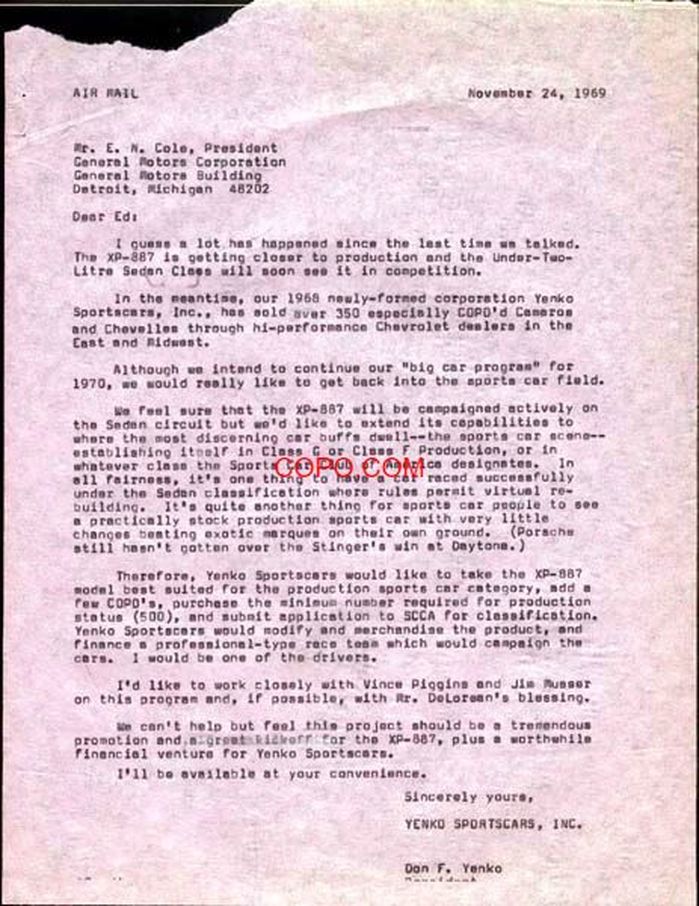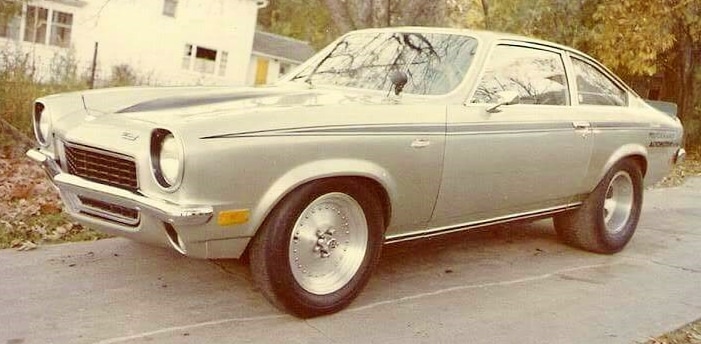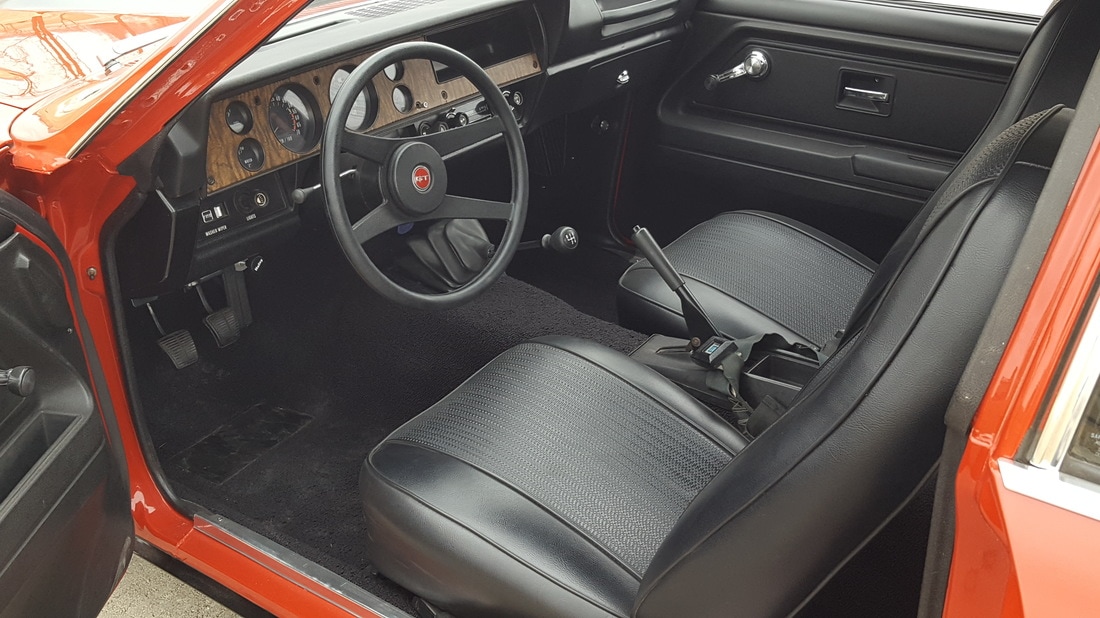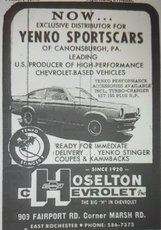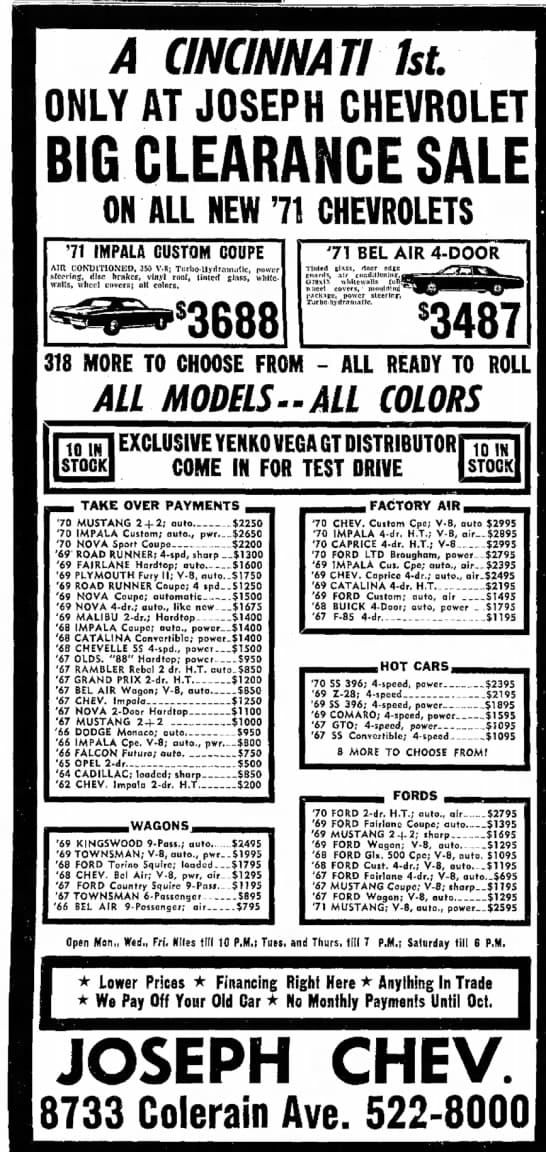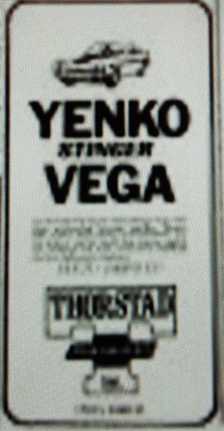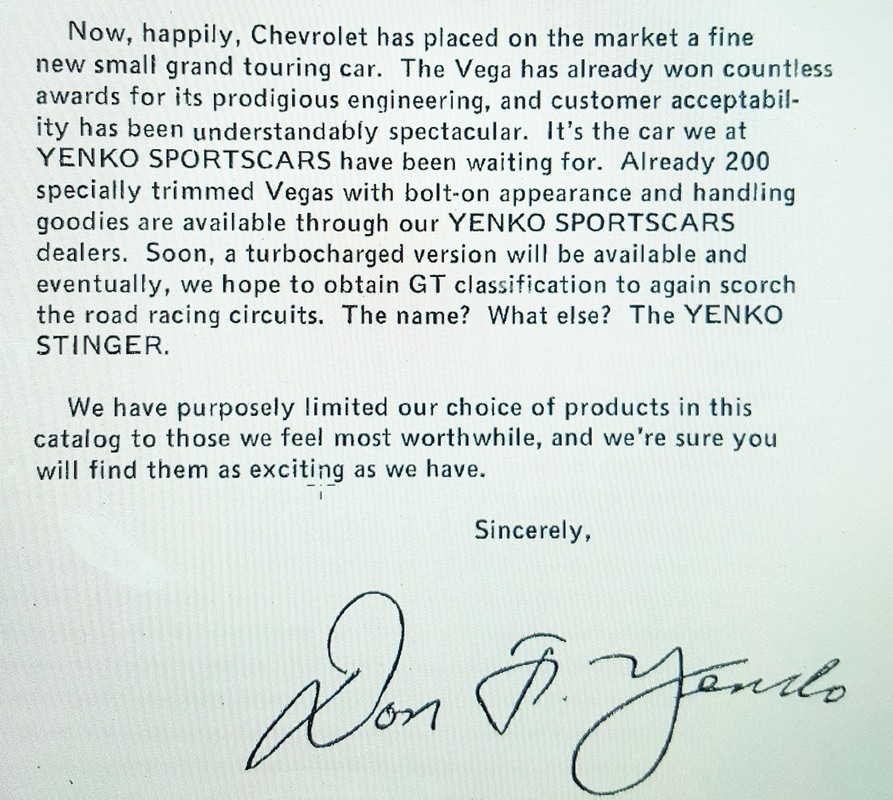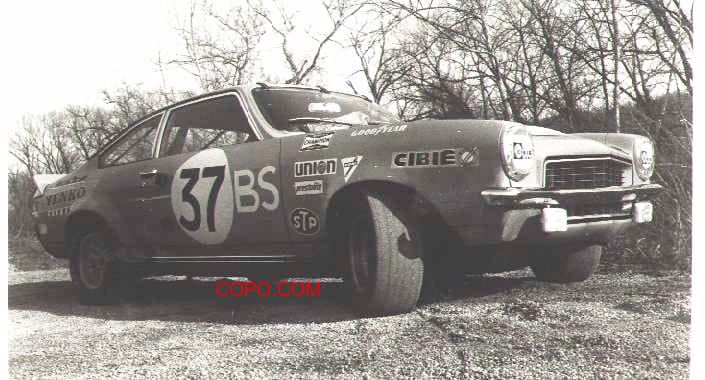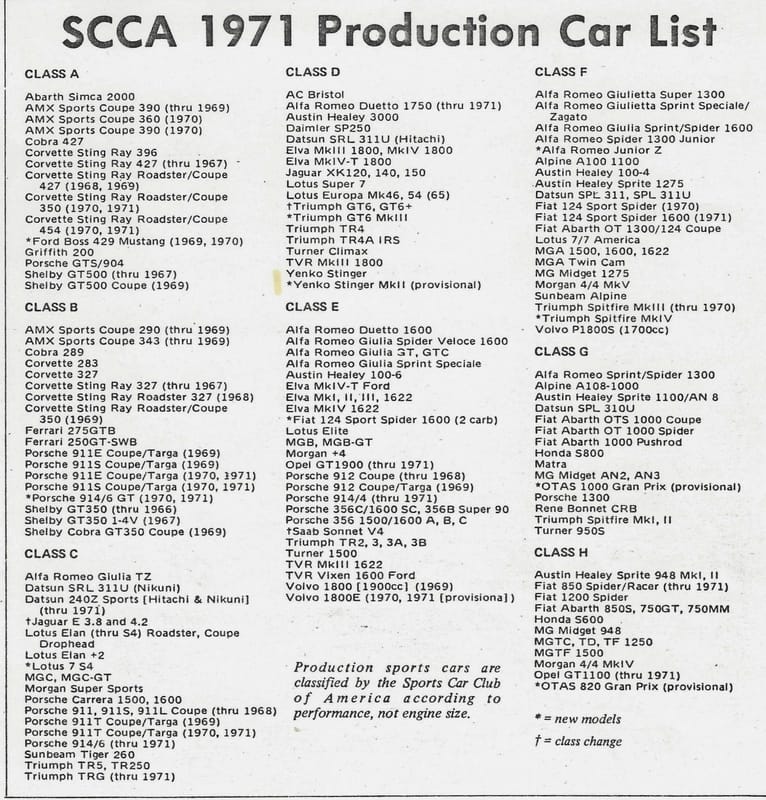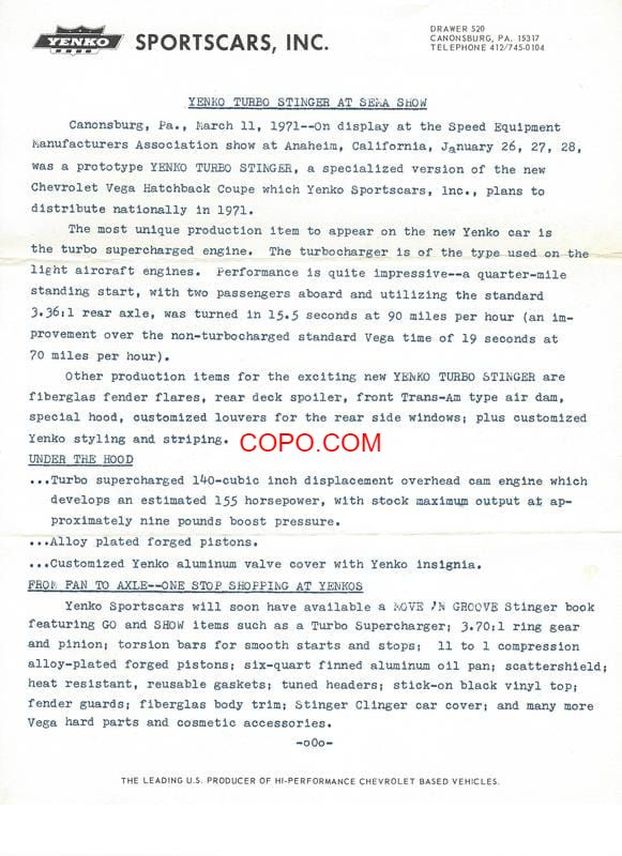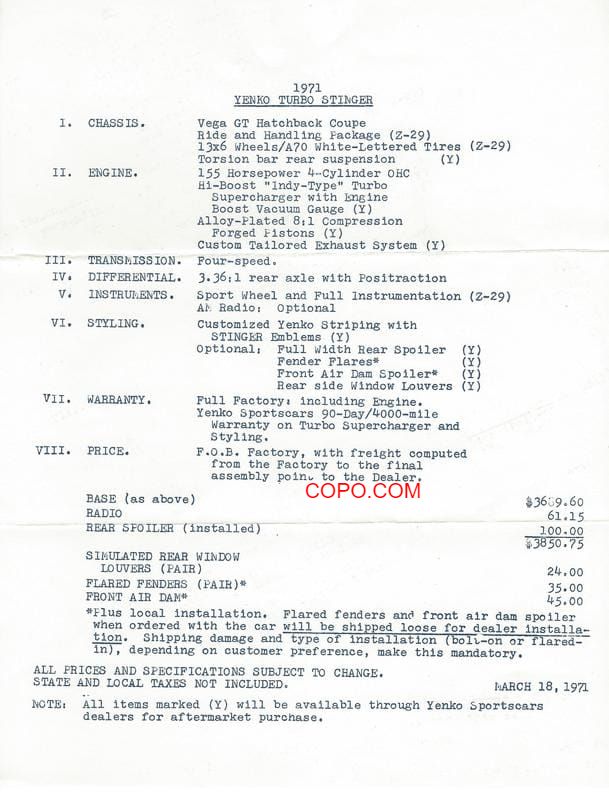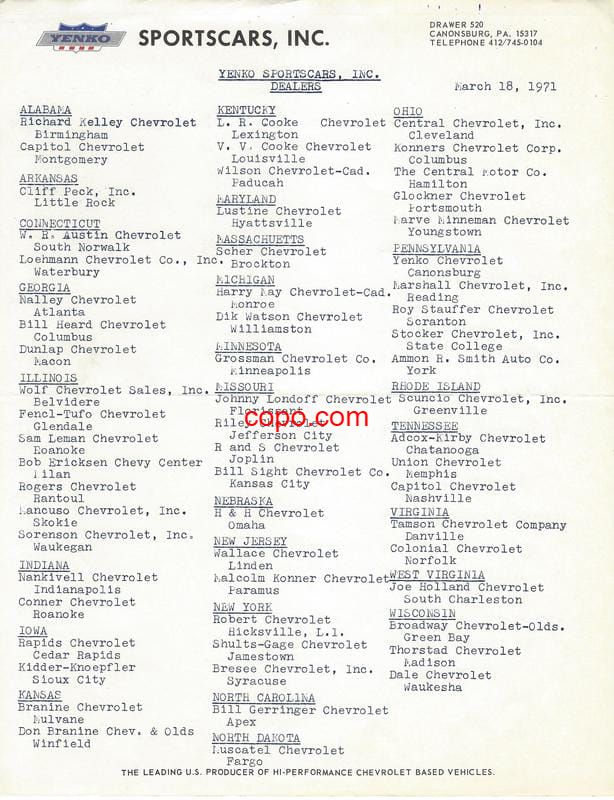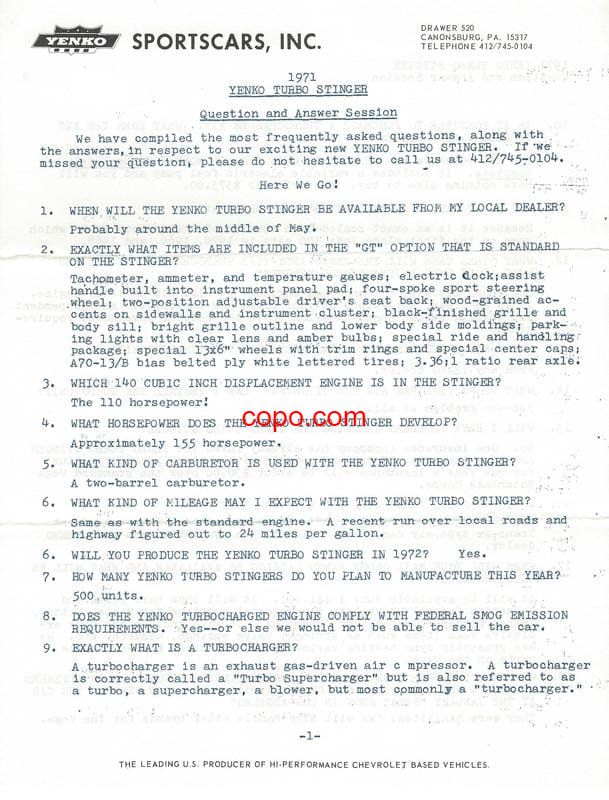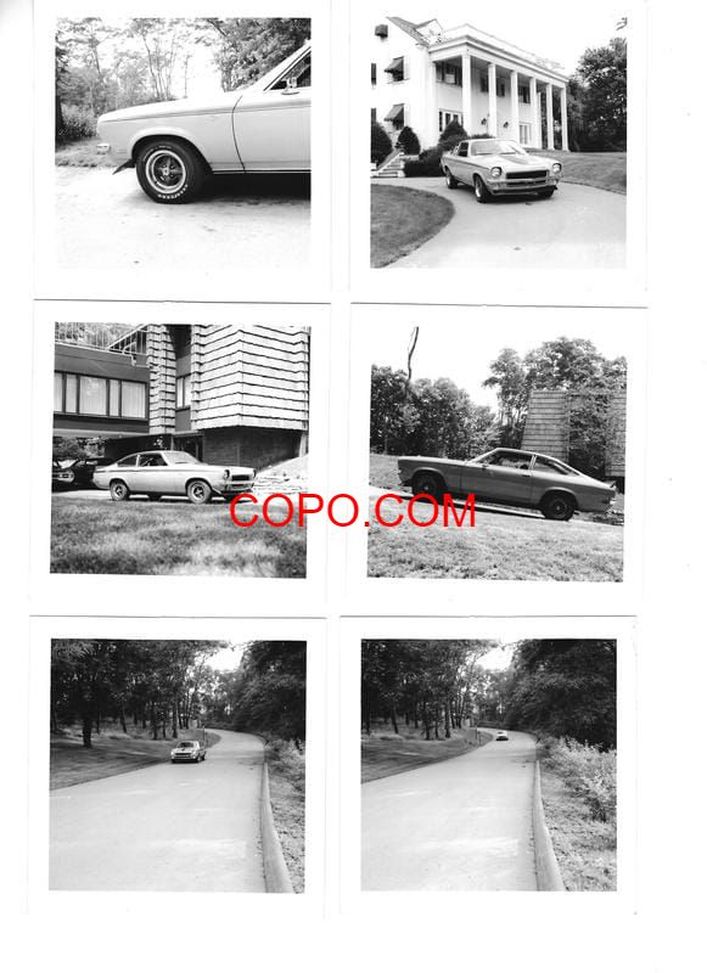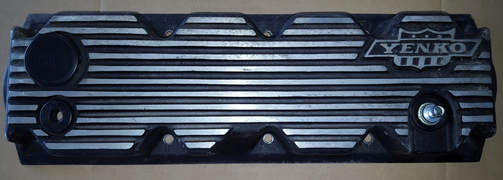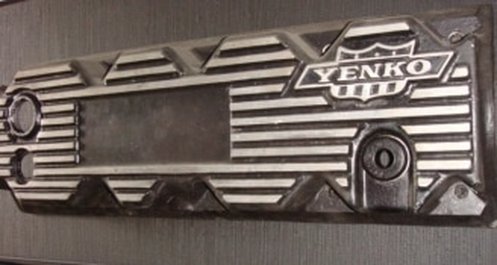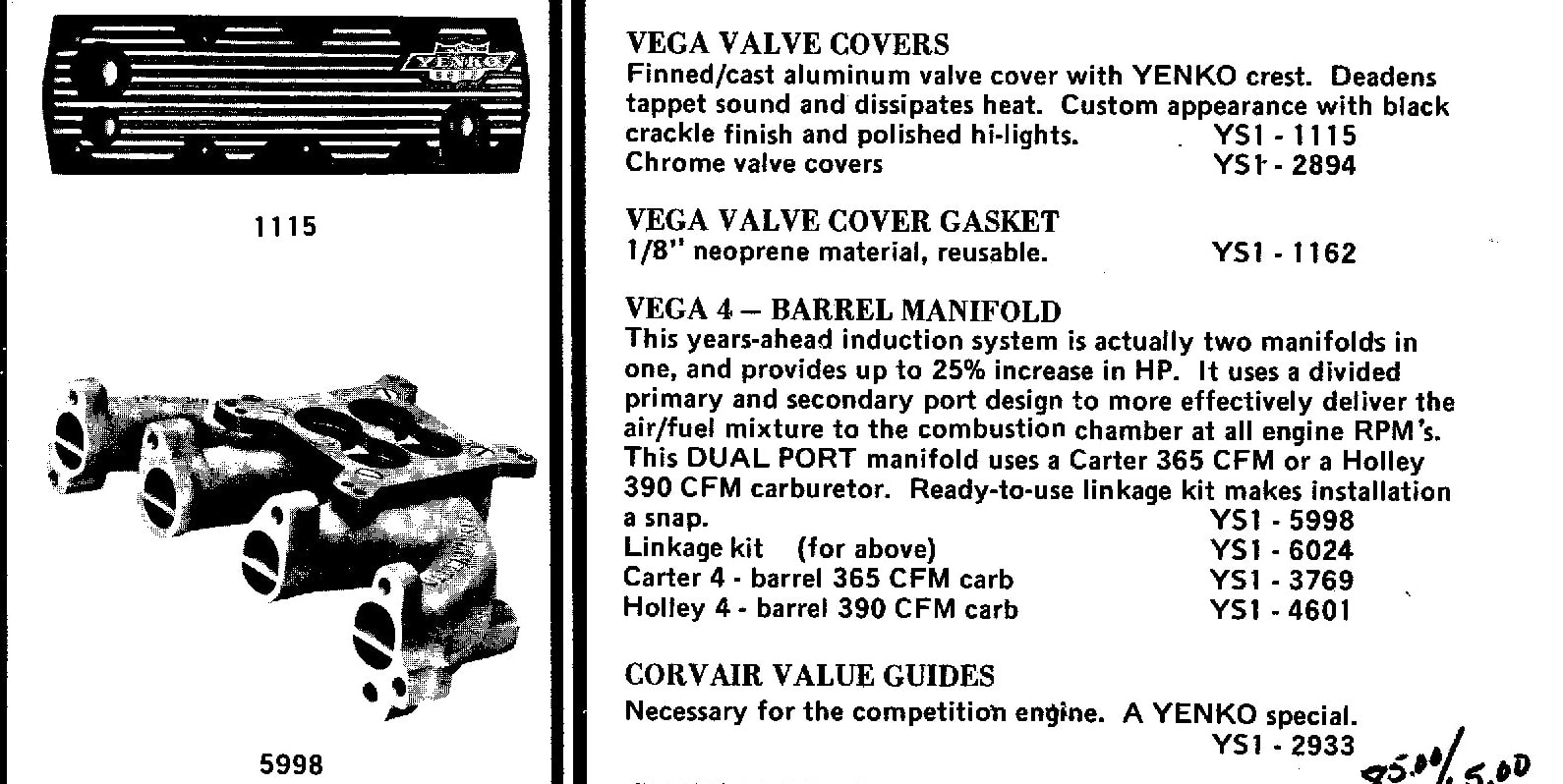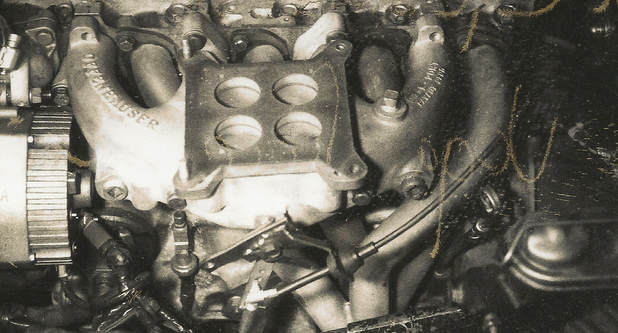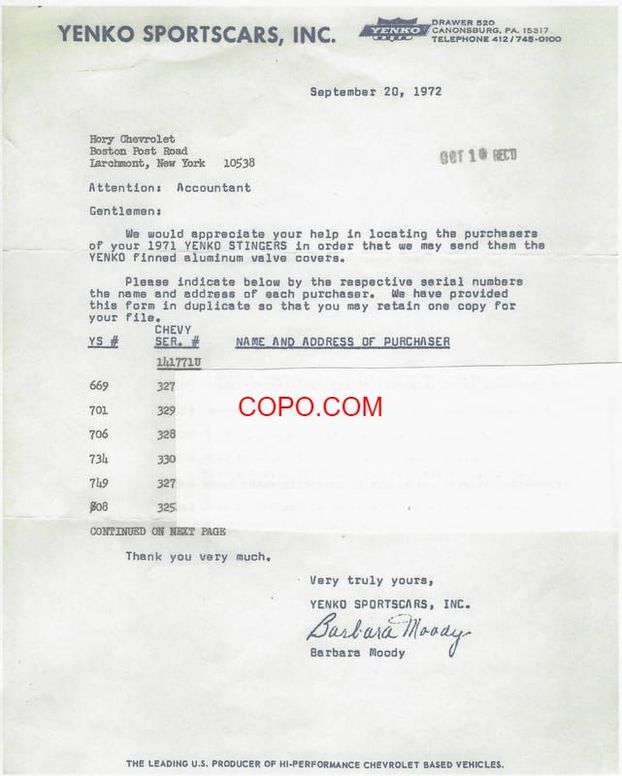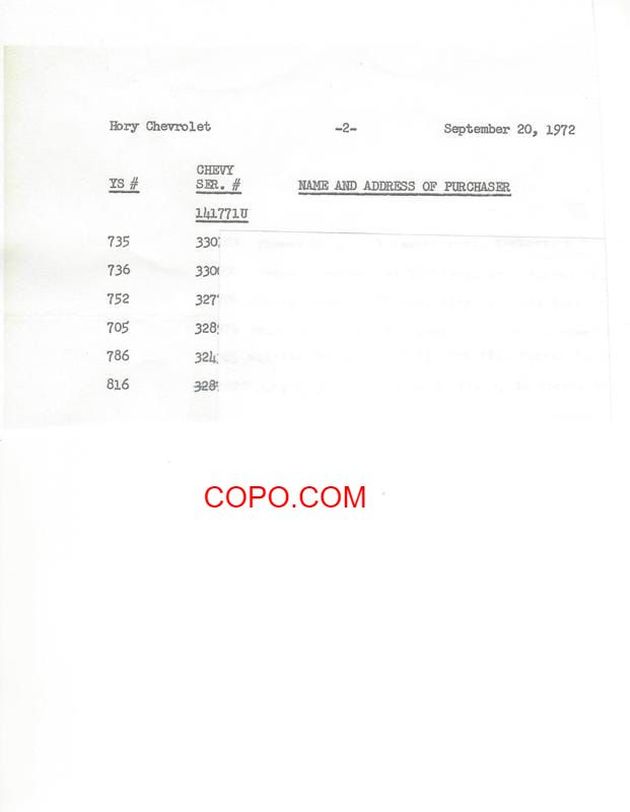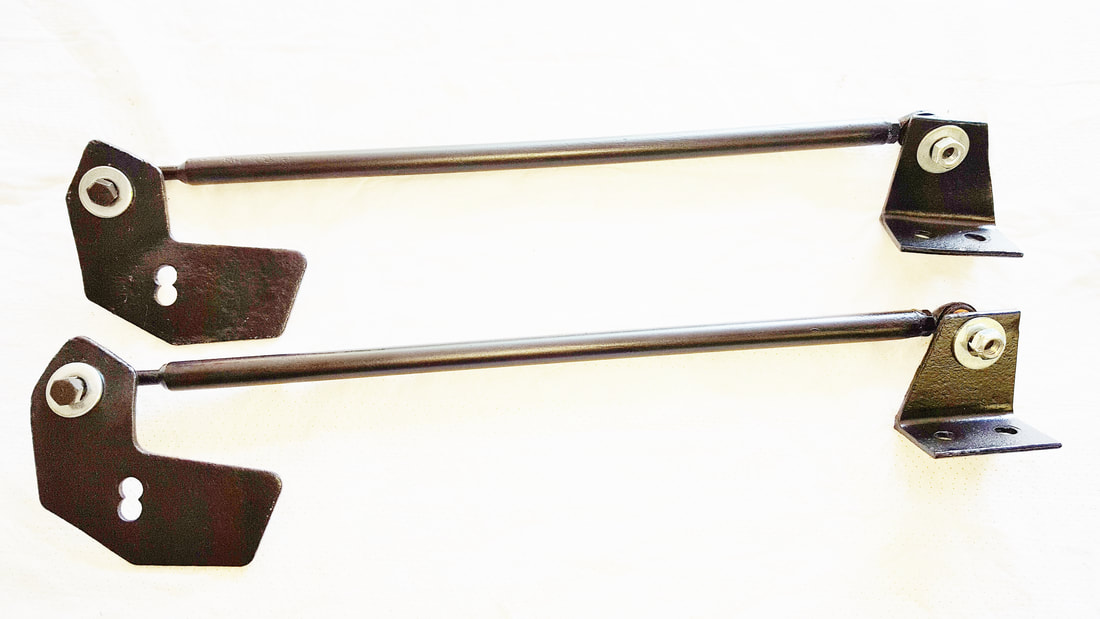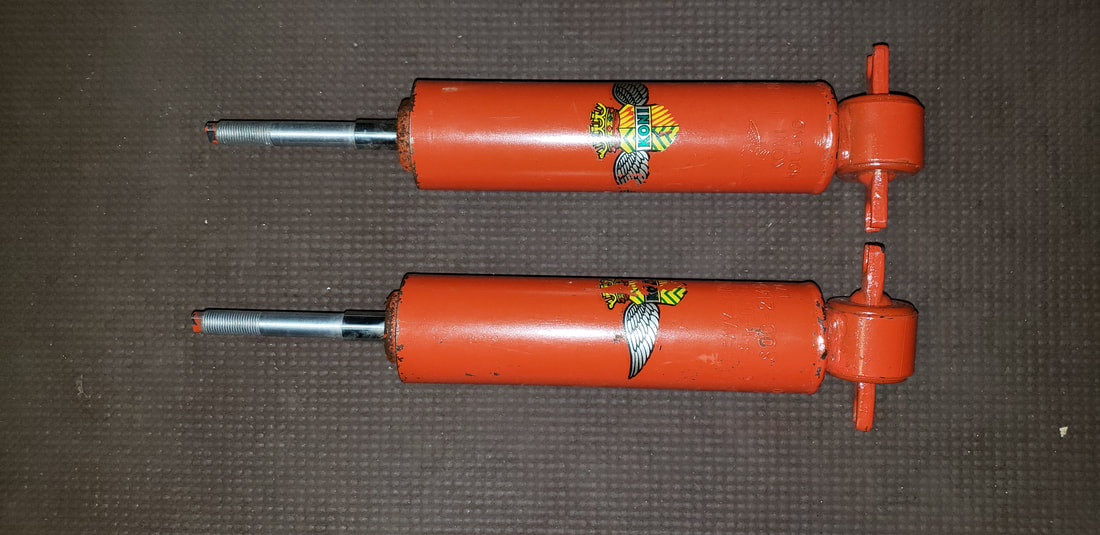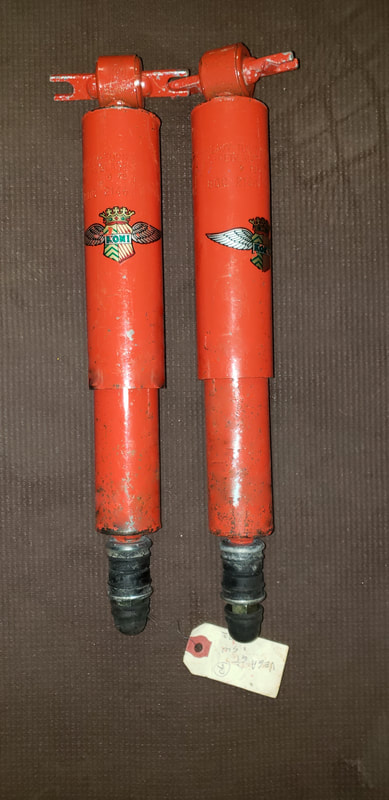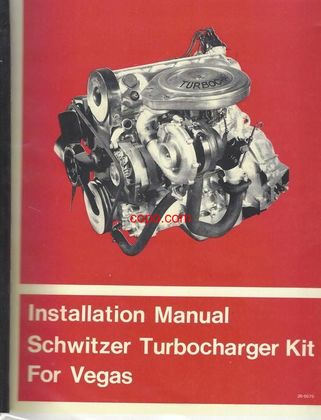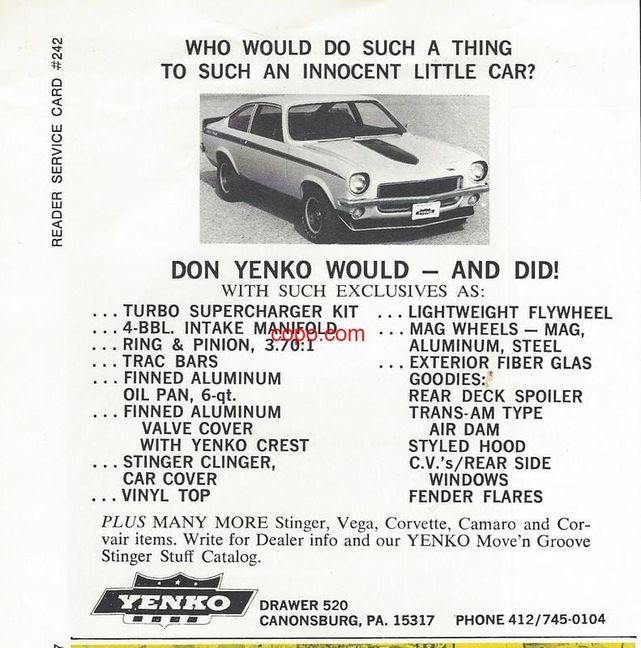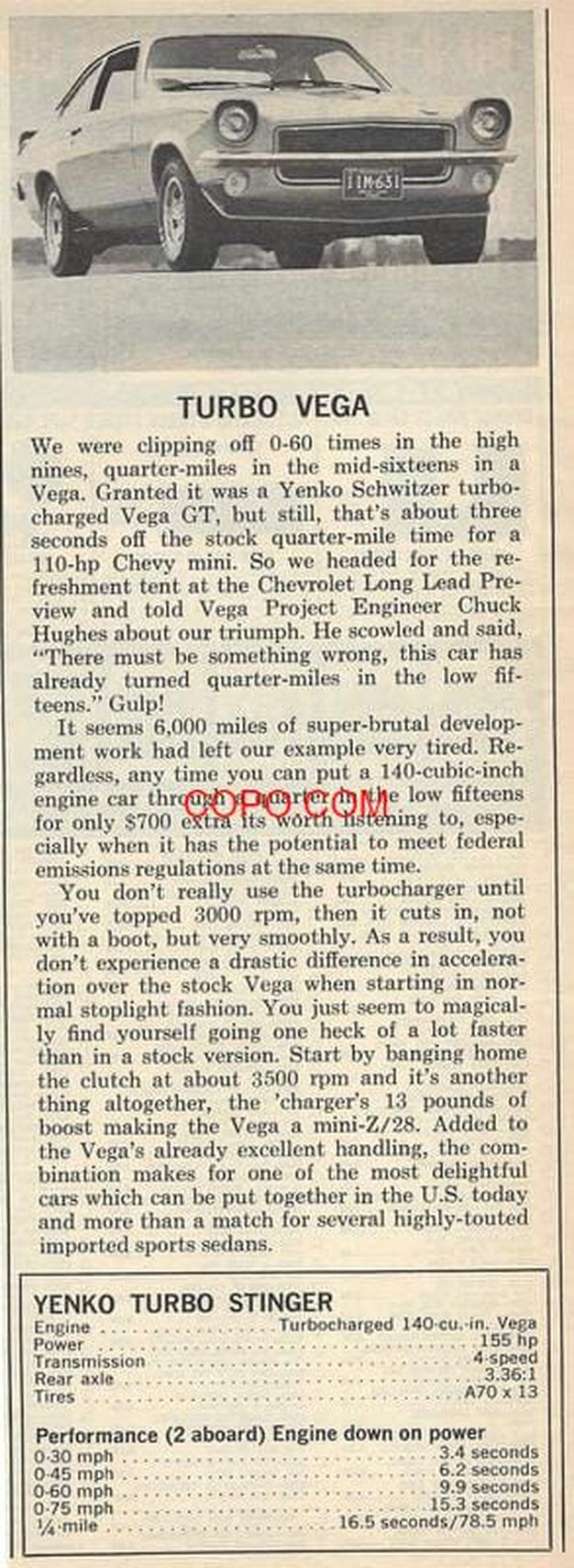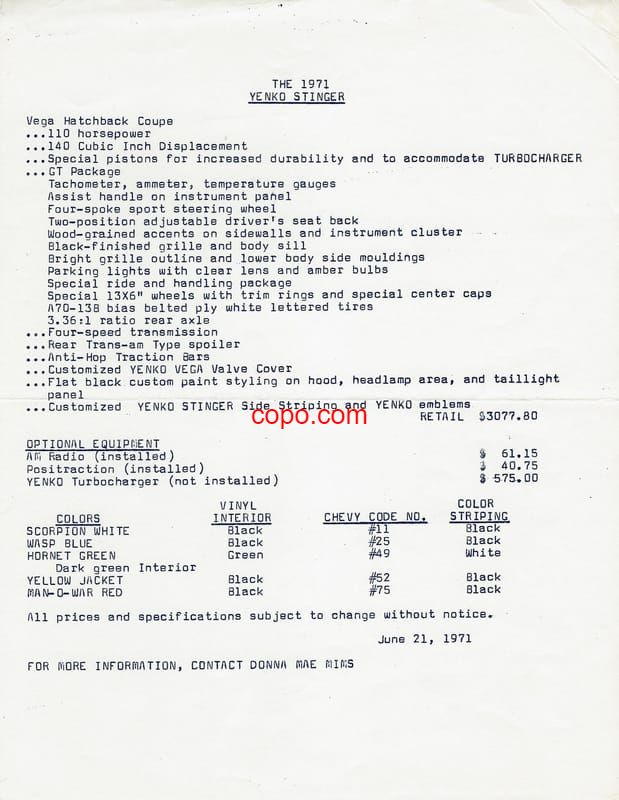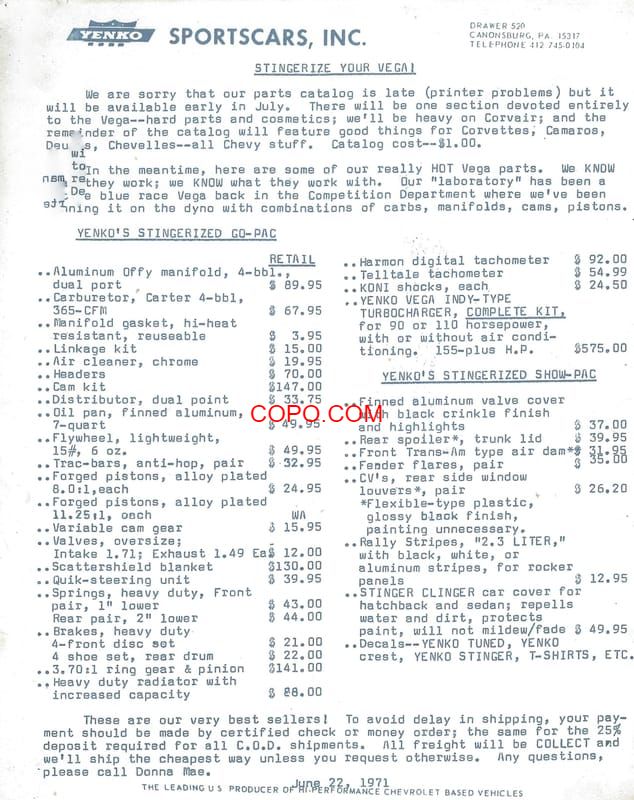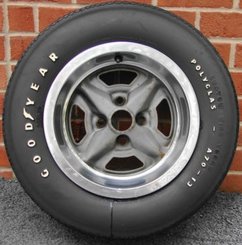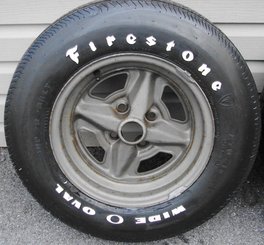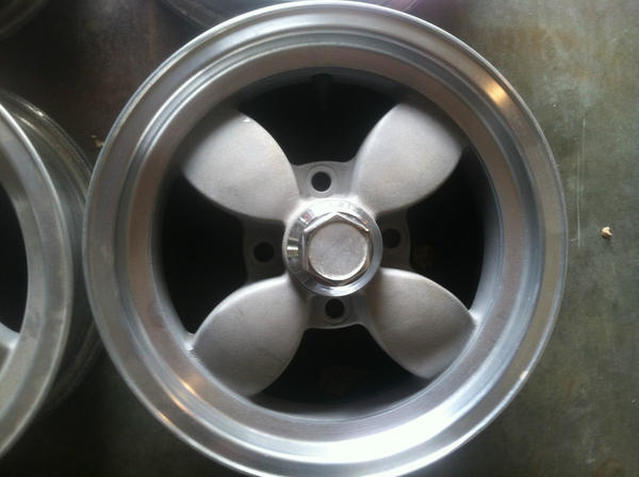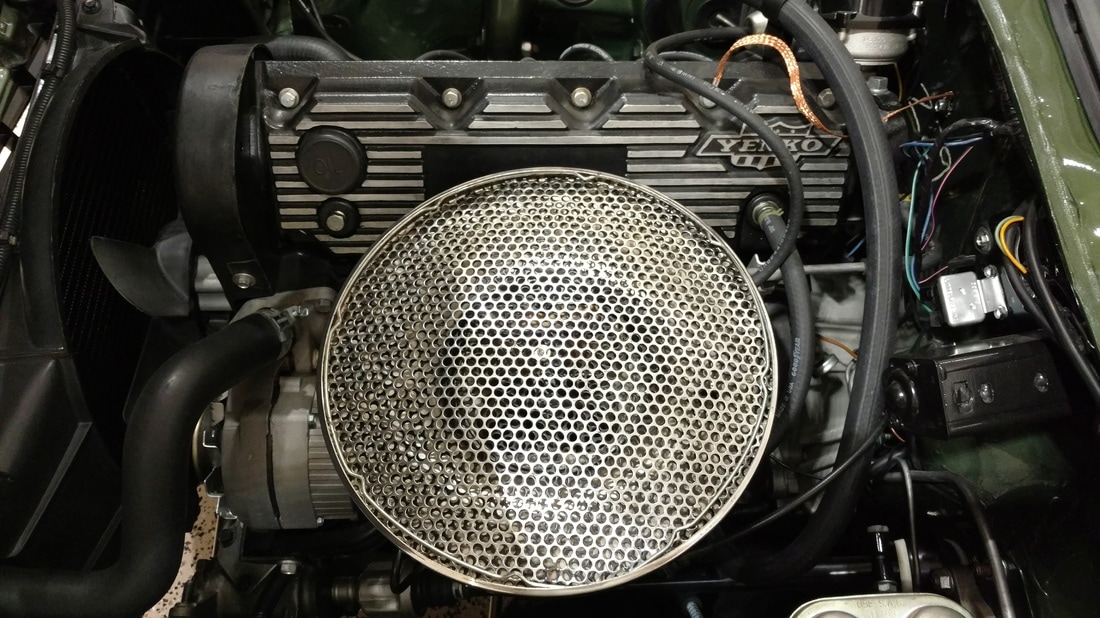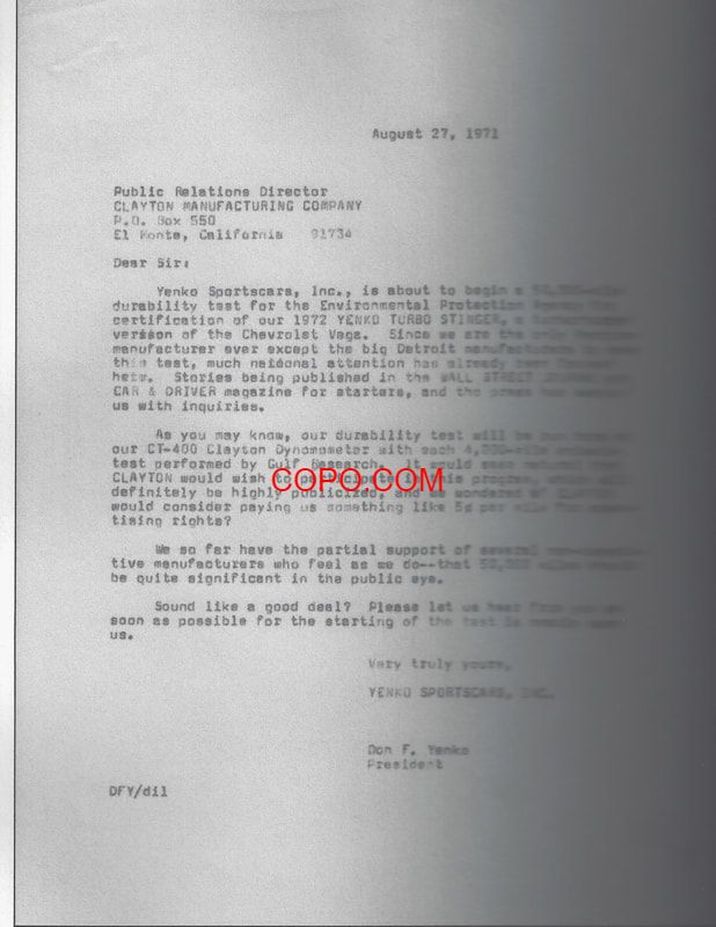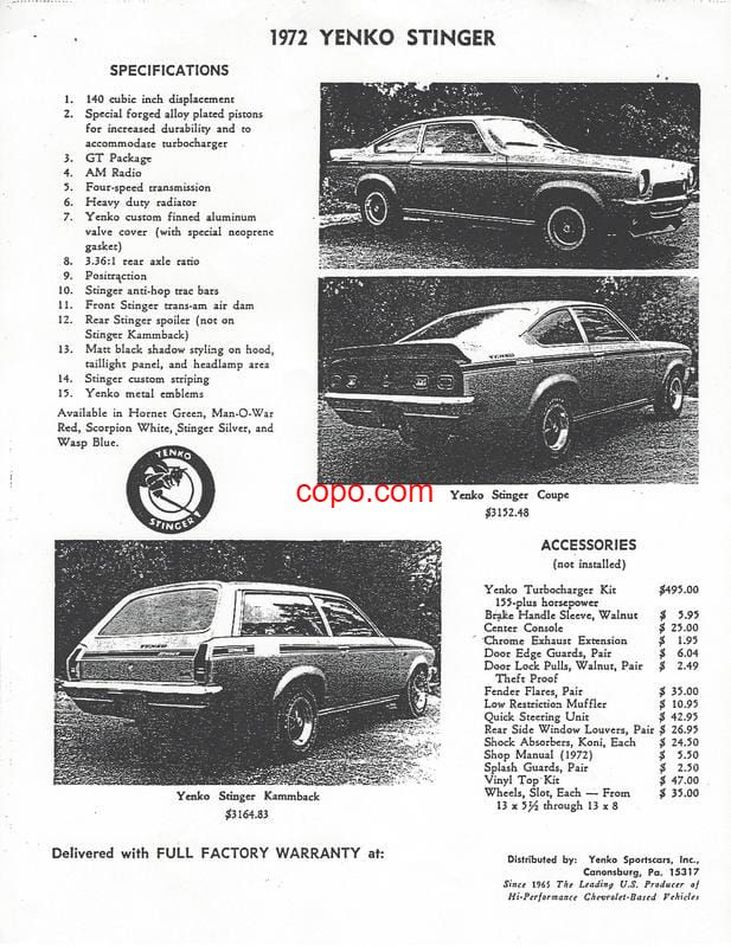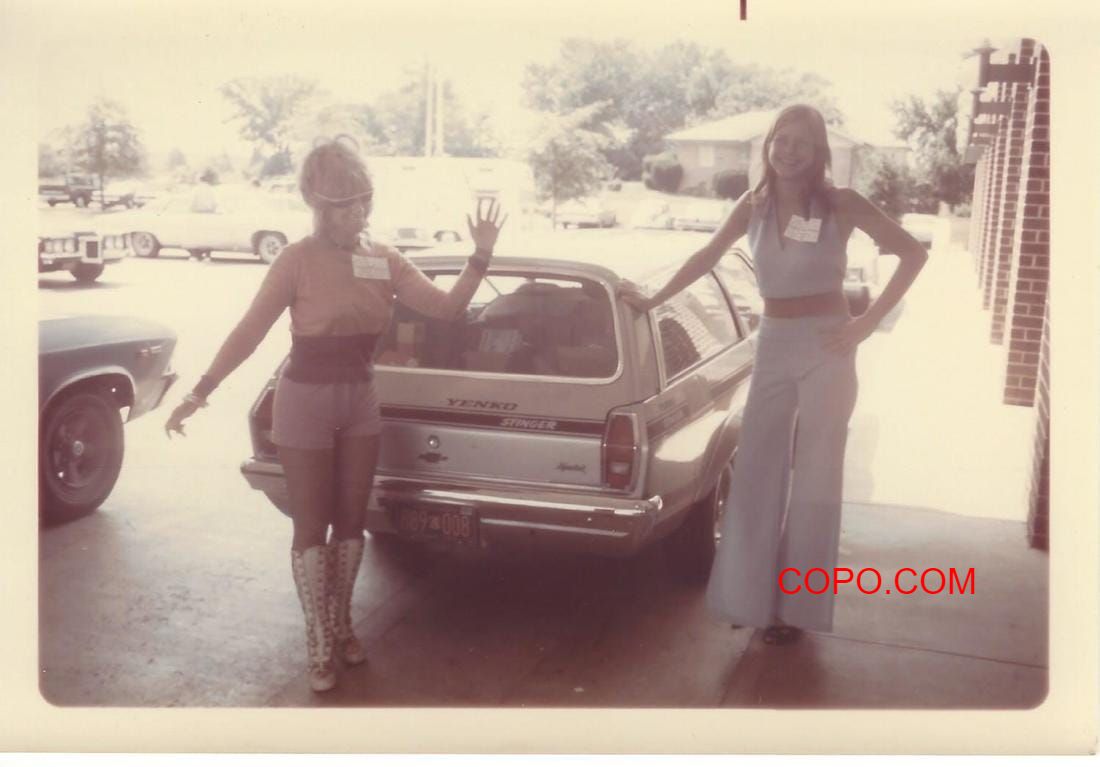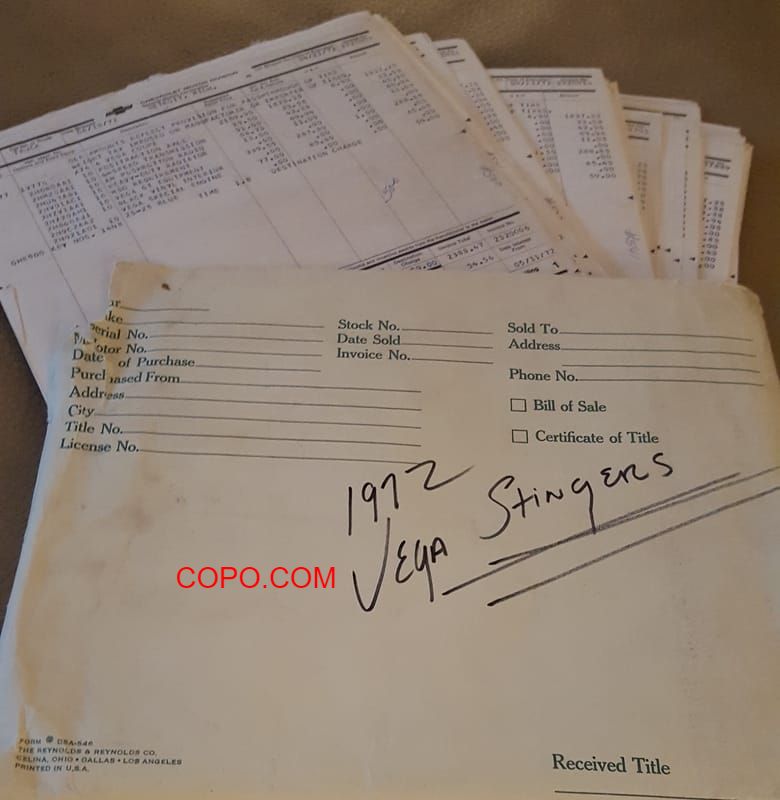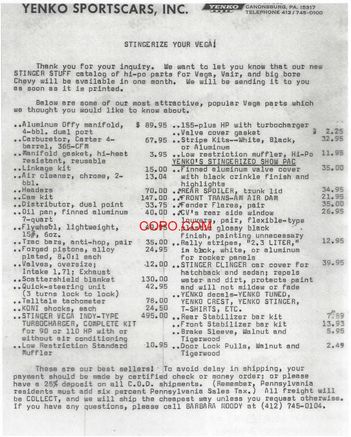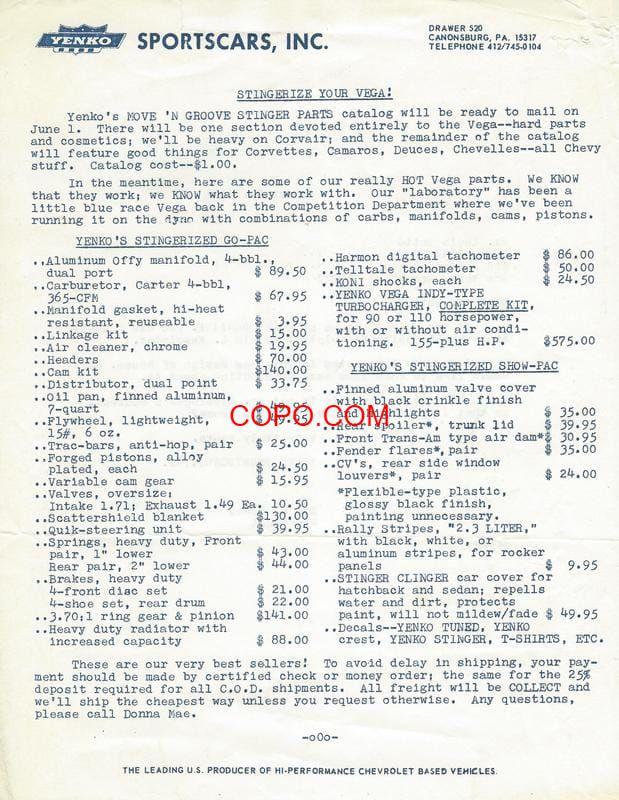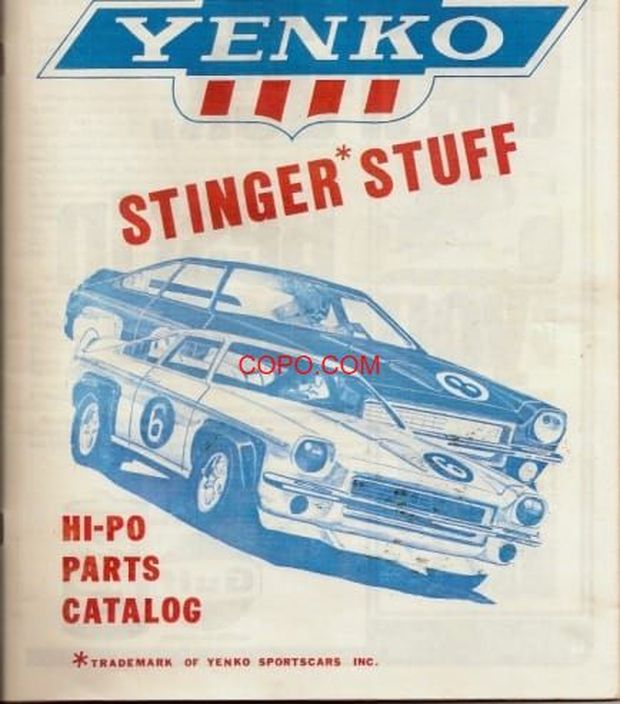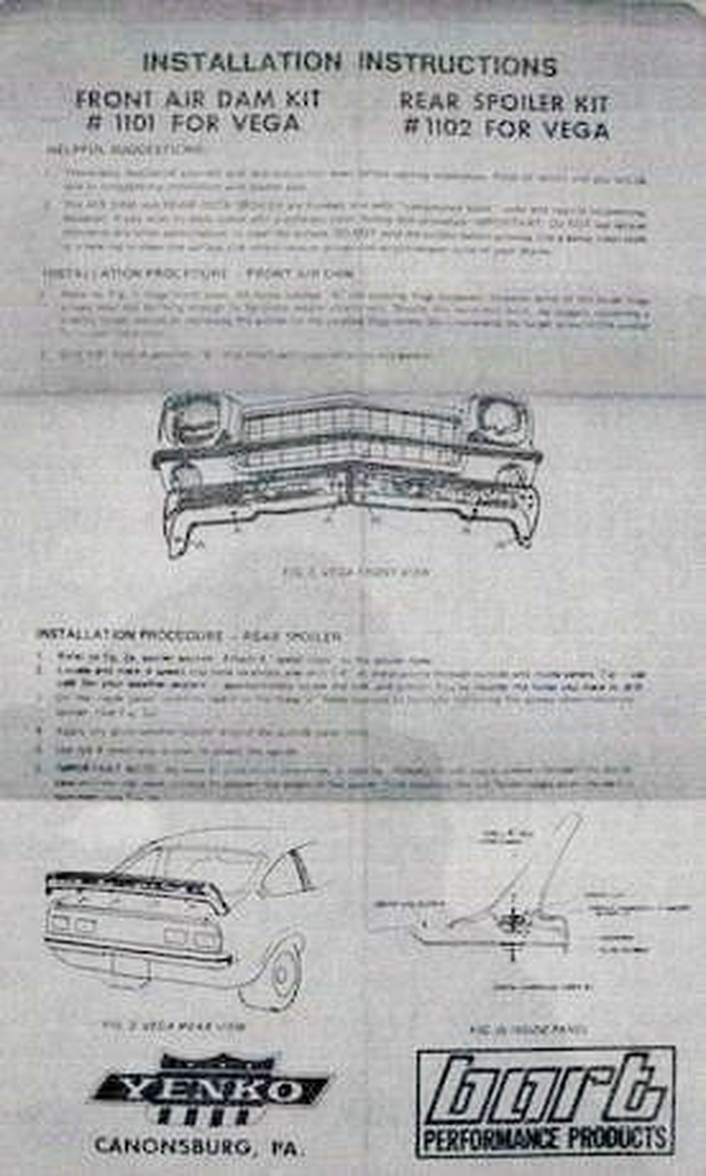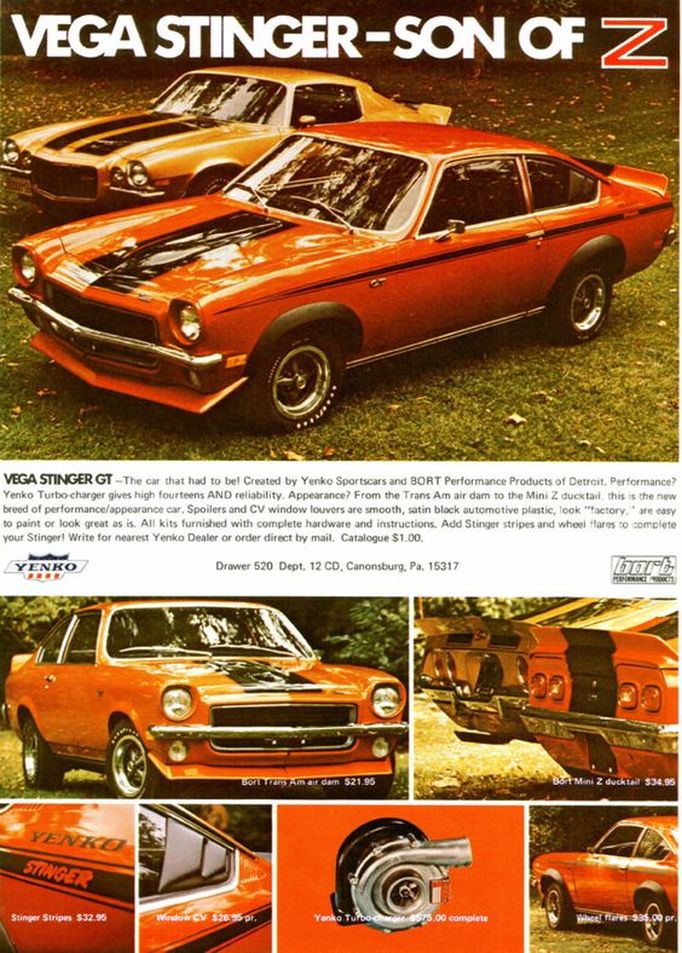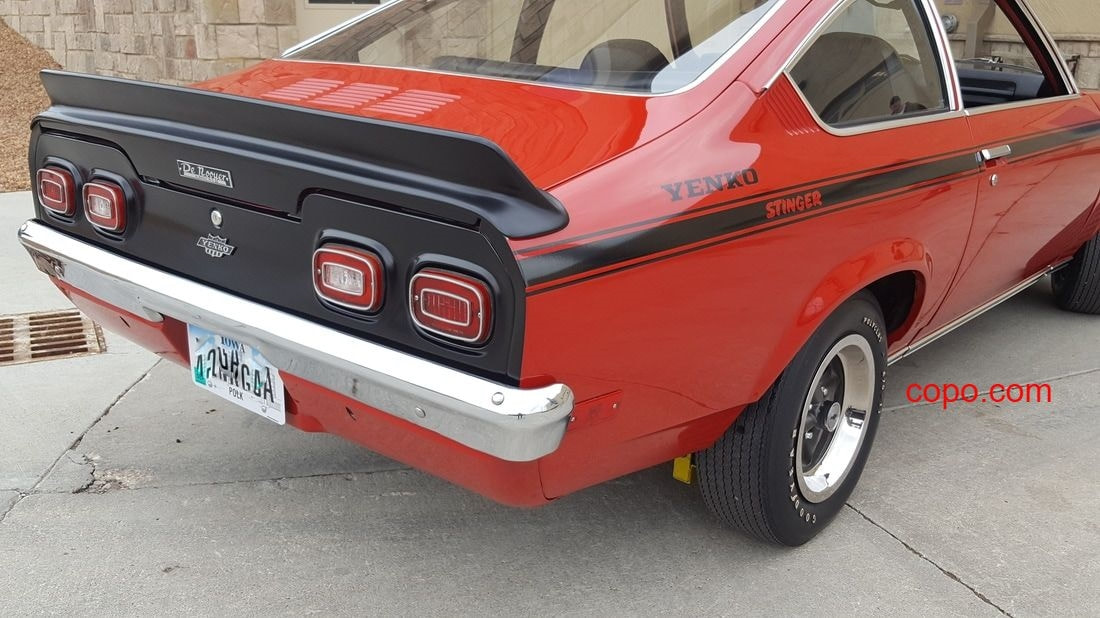
Ted Cunneen working on 1971 Stinger YS-733
YENKO COPO STINGER VEGAS BUILT
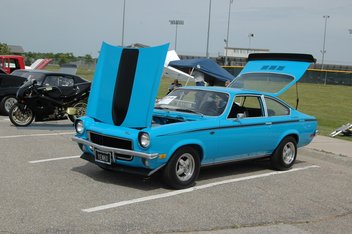
Records show that Don Yenko's original plan was to order 500 GT Vegas (SCCA minumum production) and convert them into Turbo Stingers.
He placed an initial order for 200 COPO Vegas early in 1971, built in June, 1971. At that time Yenko was having issuses certifying the Turbocharger with the EPA, but he felt confident that by 1972, he would have the issue resolved. A second order of 200 GT's was processed in spring 1972 and were built in April, 1972. But hope of a production Turbo was never realized, and the program ended with a total of 400 COPO Vegas converted.
The COPO option was 9734AA and was listed as 9C2AA2 - Special Vega Engine on the Chevrolet invoices and Window Stickers, and included forged aluminum pistons intended to withstand the pressures of the Turbocharger.
These engines were identified by a unique engine identification stamp in each year.
The Vegas were built at Lordstown, Ohio.
The 1972 order also included 50 Kammbacks.
There was a 1973 Giveaway Yenko Stinger, but it is uncertain how this car was ordered.
Yenko selected five different exterior colors each year as follows:
1971*
Exterior Color Code YS-Nos. VIN Seq. Quantity Type
Man-O-War Red 75-75 700-739 325xxx-330xxx 40 Coupe
Wasp Blue 25-25 740-779 313xxx-337xxx 40 Coupe
Yellow Jacket 52-52 780-819 325xxx 40 Coupe
Scorpion White 11-11 820-859 324xxx-325xxx 40 Coupe
Hornet Green 49-49 860-899 40 Coupe
* 1971 records are incomplete, therefore the YS Number range per color is estimated
Note: 1971 Stingers received black interiors, with the exception of Hornet Green Coupes. which received green interiors
1972
Exterior Color Code YS-Nos. VIN Quantity Type
Wasp Blue 25-25 500-529 355xxx-358xxx 30 Coupe
Man-O-War Red 75-75 530-559 355xxx-359xxx 30 Coupe
Scorpion White 11-11 560-589 367xxx-458xxx 30 Coupe
Hornet Green 49-49 590-619 367xxx-372xxx 30 Coupe
Stinger Silver 14-14 620-649 358xxx-373xxx 30 Coupe
Wasp Blue 25-25 650-659 368xxx-372xxx 10 Wagon
Man-O-War Red 75-75 660-669 368xxx-373xxx 10 Wagon
Scorpion White 11-11 670-679 368xxx-371xxx 10 Wagon
Hornet Green 48-48 680-689 357xxx-359xxx 10 Wagon
Stinger Silver 14-14 690-699 368xxx-372xxx 10 Wagon
Note: 1972 Stingers received black interiors, with the exception of Hornet Green Coupes and Wagons, which received green interiors
July 3, 1969 and November 24, 1969 letters showing interest by Don to compete with the Vega.
The letter below to Goodyear is the only mention I have found of the "Yenko Stinger 2" designation
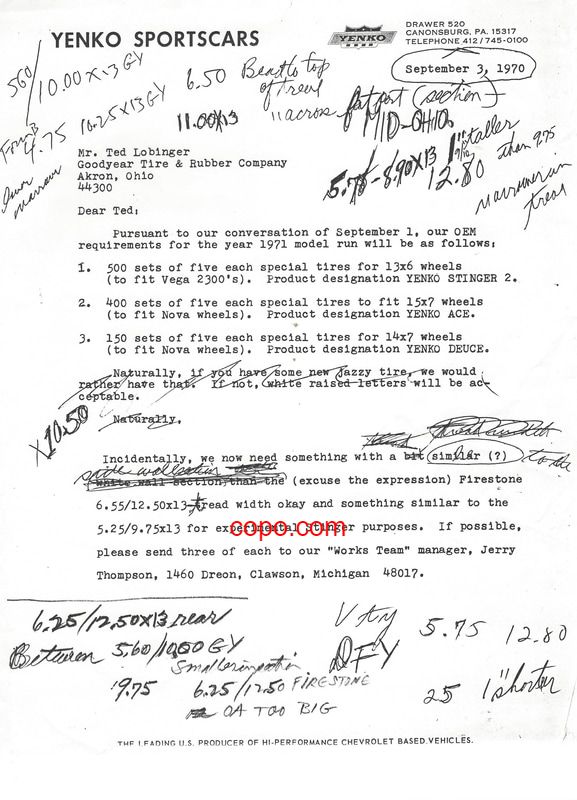
In September, 1970 Yenko had intended to order 500 Vegas to meet the minimum requirements for SCCA Sports Car Club racing.
Yenko utimately ordered the Vegas with the GT package, which included either the Goodyear or Firestone RWL tires in A70x13 size. Both tires were used.
Yenko utimately ordered the Vegas with the GT package, which included either the Goodyear or Firestone RWL tires in A70x13 size. Both tires were used.
FACTORY and YENKO OPTIONS
Yenko Stingers were ordered with the following factory options:
M-20 4-speed Transmissions
V01 Heavy Duty radiator (ordered in 1972 only)
G80 Positraction axle with a 3.36:1 ratio.
U63 AM radio (Windshield Antenna)
9C2 Special engine using forged aluminum coated pistons for improved durability
860 Black Standard Interior (Green was used for Hornet Green Hatchbacks and Kammbacks)
Z29 Vega GT Equipment
The GT package included the following features:
* Parking Lamp Clear Lens, Amber Bulb
* Bright Belt Reveal Molding (Excluded on Kammback Models)
* Body Side Lower Molding (Black Paint Full)
* Black Grille, Bright Molding
* Deluxe Instrument Panel Pad and Assist Handle
* Special Gauge Instrument Cluster, Clock, and Wood Grain Trim
* Special 4-Spoke Vinyl Steering Wheel
* 2-Position Adjustable Driver's Seat
* Front Fender GT Emblems (Substituted with Yenko Crest)
* Black Painted Rocker Panel
* Outside Door Handle Colored Insert
* Trim Rings (RPO P06)
* Four Spoke Stamped Wheels
* F41 Suspension and A70x13 White Letter Tires included with GT Package
Stinger Options include:
*Exterior Yenko Striping
*Yenko Crest Emblems
*Special paint on hood and rear panel
*Traction Bars
*Front and Rear one piece Plastic Spoilers
*Black Accented Headlight Bezels
*Aluminum Valve Cover with Yenko Crest
Note: Many 1971 Stingers were sold without the aluminum valve cover due to being back ordered
Other options were available at extra cost from the STINGER STUFF Catalog
Surviving Stingers show options such as Offenhauser Intakes, 4-barrel Holley Carbs, Fly-eye Air Cleaners, and Headers. Yenko, as a dealer, could not install these options on the cars prior to sale. There were also a few Stingers that received Turbochargers in the trunk.
M-20 4-speed Transmissions
V01 Heavy Duty radiator (ordered in 1972 only)
G80 Positraction axle with a 3.36:1 ratio.
U63 AM radio (Windshield Antenna)
9C2 Special engine using forged aluminum coated pistons for improved durability
860 Black Standard Interior (Green was used for Hornet Green Hatchbacks and Kammbacks)
Z29 Vega GT Equipment
The GT package included the following features:
* Parking Lamp Clear Lens, Amber Bulb
* Bright Belt Reveal Molding (Excluded on Kammback Models)
* Body Side Lower Molding (Black Paint Full)
* Black Grille, Bright Molding
* Deluxe Instrument Panel Pad and Assist Handle
* Special Gauge Instrument Cluster, Clock, and Wood Grain Trim
* Special 4-Spoke Vinyl Steering Wheel
* 2-Position Adjustable Driver's Seat
* Front Fender GT Emblems (Substituted with Yenko Crest)
* Black Painted Rocker Panel
* Outside Door Handle Colored Insert
* Trim Rings (RPO P06)
* Four Spoke Stamped Wheels
* F41 Suspension and A70x13 White Letter Tires included with GT Package
Stinger Options include:
*Exterior Yenko Striping
*Yenko Crest Emblems
*Special paint on hood and rear panel
*Traction Bars
*Front and Rear one piece Plastic Spoilers
*Black Accented Headlight Bezels
*Aluminum Valve Cover with Yenko Crest
Note: Many 1971 Stingers were sold without the aluminum valve cover due to being back ordered
Other options were available at extra cost from the STINGER STUFF Catalog
Surviving Stingers show options such as Offenhauser Intakes, 4-barrel Holley Carbs, Fly-eye Air Cleaners, and Headers. Yenko, as a dealer, could not install these options on the cars prior to sale. There were also a few Stingers that received Turbochargers in the trunk.
1971 STINGER VEGA OWNER REGISTRY
YS VIN COLOR DEALER STATE
767 313177 Wasp Blue Joseph Chevrolet Cincinnati, OH
XXX 325197 Man-o-War Red Thurstad Chevrolet Madison, Wisc.
733 330262 Man-o-War Red Lou Bachrodt Chevrolet Rockford, IL
Any additional known owner's would be welcome.
767 313177 Wasp Blue Joseph Chevrolet Cincinnati, OH
XXX 325197 Man-o-War Red Thurstad Chevrolet Madison, Wisc.
733 330262 Man-o-War Red Lou Bachrodt Chevrolet Rockford, IL
Any additional known owner's would be welcome.
1972 STINGER VEGA OWNER REGISTRY
YS VIN COLOR DEALER STATE *
509 357061 Wasp Blue Galles Chevrolet* Albuquerque, NM
555 359097 Man-O-War Red DeNooyer Chevrolet Albany, NY
643 358149 Stinger Silver Fencl Tufo Chevrolet Glendale Heights, IL
687 357664 Hornet Green Galles Chevrolet* Albuquerque, NM wagon
* Still verifying dealerships
Any additional known owner's information would be welcome
Sportscar Dealer Ads for Yenko Stingers
Introduction letter in the Fall, 1970 release of Stinger Stuff Catalog
The era of high performance cars came crashing down around Don Yenko in 1970. His last successful attempt to promote his supercars was the 1970 Yenko Deuce Nova, a 350 cubic inch LT1 powerhouse.
Times were changing, which meant he had to also change stragedy to keep his vision alive.
There was a possibility. The SCCA finally found enough "under" 2.5 liter cars to categorize a class in D production. And the new Chevrolet Vega, as well as the Ford Pinto, would fit in this class, but neither seemed to have enough horsepower to compete with the international competitors.
As a starting point to gage the Vega's performance, Yenko decided to enter a proto-type Blue Vega into the 24 Hours of Daytona Race, attempting to prove it's ability. In January, 1971 Donna Mae Mims, Bob Johnson, Kirt Wetzel, and Bob Nagel were set to co-drive the car in B Sedan Class.
Warren Dernosheck was crew chief.
Unfortunetly, the Vega did not muster up enough power to remain competitive, and after days of testing and attempts, the Vega did not end up competing.
The 24 Hours of Daytona took place January 31,1971 without a Vega or Pinto present.
Times were changing, which meant he had to also change stragedy to keep his vision alive.
There was a possibility. The SCCA finally found enough "under" 2.5 liter cars to categorize a class in D production. And the new Chevrolet Vega, as well as the Ford Pinto, would fit in this class, but neither seemed to have enough horsepower to compete with the international competitors.
As a starting point to gage the Vega's performance, Yenko decided to enter a proto-type Blue Vega into the 24 Hours of Daytona Race, attempting to prove it's ability. In January, 1971 Donna Mae Mims, Bob Johnson, Kirt Wetzel, and Bob Nagel were set to co-drive the car in B Sedan Class.
Warren Dernosheck was crew chief.
Unfortunetly, the Vega did not muster up enough power to remain competitive, and after days of testing and attempts, the Vega did not end up competing.
The 24 Hours of Daytona took place January 31,1971 without a Vega or Pinto present.
The failed Daytona race did not deter Don's enthusiasm.
This new creation could be a dream come true for Yenko.It was a brand new, concept car, built in a state of the art facility in Lordstown, Ohio. It would soon receive honors as Motor Trend's Car of the Year.
But the Vega needed horsepower. That is where Don stepped in. If a turbocharger was added to the anemic 4 cylinder engine, it quite possibly could become a contender on the street. Yenko obtained a Vega to be used as a mule for this testing.
Initial testing of the New Stinger program was favorable. Many of the top car magazines wrote articles on theTurbo Stinger's’s potential. There were discussions Don had with Chevrolet about doing a COPO to include the turbocharger option, but this fell on deaf ears. As a final concession, Chevrolet allowed a COPO for special forged aluminum pistons, which Chevrolet believed were necessary for engine longevity with a Turbo.
The special COPO was listed as "9CH2AA -Vega Special Engine" on the Chevrolet Invoices.
All was a good to go. A COPO order for 200 of the mandatory 500 cars necessary to compete in SCCA was remitted, and after a month or two of paperwork delays and red tape, the specially equipped Vega GT's were produced in the second week of June, 1971.
Don had set up four hubs to handle the conversions and forty dealerships to sell the cars.
All was in place for a terrific year of racing and selling cars.
Then the Brightest star began it’s decent. The government decided that any car that had the intake or exhaust modified by a dealer had to have the combination certified. This meant a 50,000 mile road test. Don tried everything to change their minds, but to no avail.
SCCA News January 15, 1971
Autoweek March 6, 1976
Prototype Yellow Turbo Stinger used for testing early in 1971
YENKO STINGER VEGA TIMELINE
Introduction of Stinger Vega at Sema in January, 1971
First Yenko Turbo Stinger Vega Price List March 18, 1971
Yenko Sportscar Dealers March 18, 1971
MAGAZINES
3-71 Sports Car Graphic Happiness is 2 1/2 Liters
4-71 Car Craft Yenko's Turbo Charged Vega
?-71 Cars From Rags to RaJays
4-71 Road and Track Yenko Turbo-Stinger
5-71 Hot Rod Turbochargerd Vega by RaJay
9-71 Car and Driver Strangers in a Strange Land (comments 10-71)
10-71 Hot Rod The New Equalizers Turbo Invasion
4-72 Super Street Cars Turbo-charged Vega testing 1971 Stinger at Hory Chevy in New York
FLYER - 1971 Yenko Turbo Stinger Questions and Answers April, 1971
AD - 1971 Vega Stinger Son of Z (12-71 Car & Driver)
AD - 1973 Group 7 Filters DO-IT-TO-IT Sweepstakes
Yenko Aluminum Valve Covers - Early 1971 version (top) and later revision with recessed rectangle.
Stinger Stuff Catalog illustrating early style valve cover and Offenhauser intake manifold
Offenhauser Dual Port Aluminum Intake used on the Stingers
Yenko sent out letters to Supercar Dealers asking for owner's addresses in order to send them the back-ordered Yenko aluminum valve cover. An example below is the letter sent to Hory Chevrolet in 1972. I eliminated Owner's names and vins for privacy purposes. Notice twelve 1971 Yenko Stingers sold to one dealer in this letter!
Yenko Stinger Vega Anti-Hop Traction Bars manufactured by Industrial Gasket & Shim Company, Inc. PA
Optional front NOS Koni Shocks.
Rear Koni Shocks Note that 1971 rear shocks (below) have different lower mounting positions than the 1972 shocks
Turbocharger Installation Manual
Yenko Production Facilities May 8 1971 publication
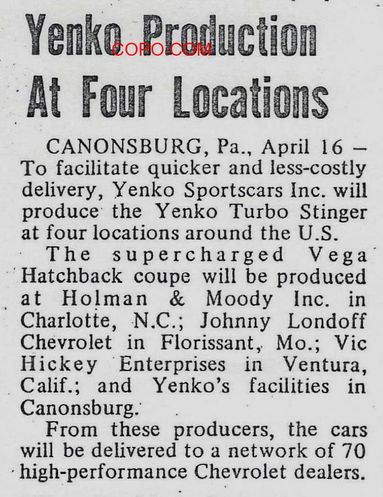
Hot Rod Industry News May, 1971
= Below 1972 Article - Where There's Smoke there's Hope - Author - unknown
Revised Price List replacing the Turbo Stinger with the Yenko Stinger Turbo now an option June 21, 1971
Stingerize Your Vega June 22, 1971 released one day after The Yenko Stinger Vega Release above.
White Lettered Tires on GT wheels were standard equipment used on the Stingers
American Racing Libre Wheels were available from the Stinger Stuff Catalog
Yenko Stinger Options 10-9-71
Anti-Hop Trac bars were manufactured by Industrial Gasket & Shim Company, Inc. Meadowlands, PA
Fly Eye Air Cleaner
Letter regarding testing of the 1972 Turbo Stinger
1972 Yenko Stingers off to the Sportscar Dealers Notice Kammback.
Sample of Yenko Documentation that COPO.COM obtained from Warren Dernoshek
Invoice for a valve cover. Purchaser's name was concealed for privacy.
STINGERIZE YOUR VEGA subsequent versions
Yenko Stuff Catalog This copy was postmarked December 8, 1971 And Don mentioned 200 Stingers were available at Sportscar Dealers.
Car and Driver April, 1973 This was a Group 7 promotion for a 1973 Stinger Vega. It is believed that the Turbo option was substituted for a monetary amount to the Winner.
Program started by Yenko and BORT Performance for customers to Stingerize their Vegas
Keep in mind that these are not Yenko COPO Stingers, which were ordered by Yenko for the Stinger program.
Keep in mind that these are not Yenko COPO Stingers, which were ordered by Yenko for the Stinger program.
We welcome any other additions you may have to complete this interesting history. Ed Cunneen


